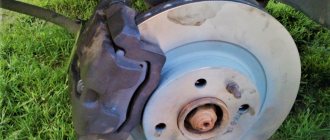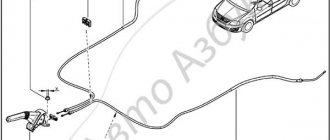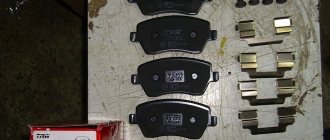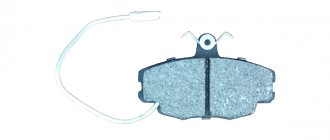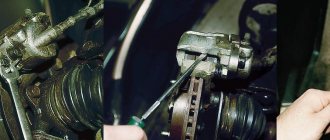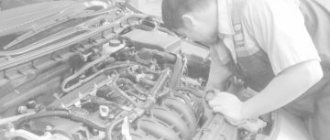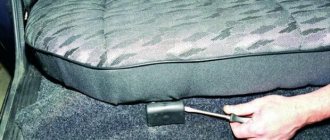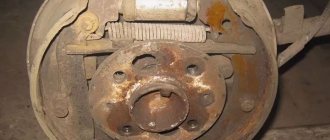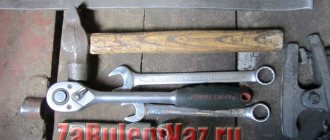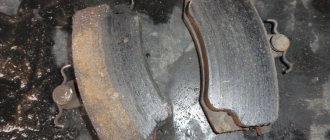Principle of operation
In order to talk sensibly about how long the pads last and after what mileage they need to be changed, it is worth asking the question: how the brake system works and what factors influence the service life of the brake pads.
In fact, the braking system of a car that is not equipped with a large number of safety and stabilization systems is designed quite primitively. By the way, even the number of components and functional units is also reduced to a minimum here.
The brake pedal has a spring mechanism that is connected to a vacuum or electric brake booster through a pipe system. This device works due to the ability of air to become rarefied and change its pressure, and its task is to multiply the force applied to the pedal. This not only takes the load off the driver, but also makes life easier for all the mechanisms whose operation lasts for more than one year.
Through the vacuum brake booster, pressure is supplied to the main brake cylinder, which is usually enough for normal operation of the brake system on any passenger car. It is a small metal cylinder with brake fluid pipes going out and going into it. Its task is to change the braking force between the wheels so that the braking is as uniform as possible. This allows you to achieve good controllability when braking and avoid various types of skidding.
It should be noted that brake pads, which usually last for 30–50 thousand kilometers, are fixed in calipers, which are some kind of fastenings. Being in such fastenings, the block does not play, and therefore the service interval is currently a fairly impressive number. How long does the caliper last? The answer to this question is quite complicated: it all depends on the make and model of the car. It is still possible to say how long a caliper lasts on a typical foreign car: usually its service life is at least 100 thousand kilometers.
Urgency
Now it’s time to answer the main question: how long do brake pads last on a car and when should they be changed? What affects their wear and the maximum mileage that is possible for a car without maintenance?
One of the fundamental factors that affects how long a car runs on the same brake pads is driving style. It's no secret that exactly how the braking is done and how often the driver has to press the pedal directly affects the service life of the brake pads and how long they last from replacement to replacement.
Obviously, the less often you have to brake, the longer the service life of the brake pads and the longer they last. However, we should not forget that the force that the pads exert on the disc has a very significant effect on the service life of a particular consumable. In this regard, to save money, it is recommended to brake as smoothly as possible and only at those moments when it is really necessary. It is worth noting that the difference in how long the pads travel with a calm and aggressive driving style is significant, and in some cases it reaches an impressive 35–40%.
Also, the quality of the consumable itself has a strong influence on how long the pads last on the car and the service mileage. It has long been known that, in order to save money, in the production of the most inexpensive pads, materials are used that not only wear out quickly, even if the driving style has always remained quite smooth, but also have weak adhesion properties. There is no need to remind once again that such a short service life of brake pads directly affects the safety of the driver and passengers, and it is especially important to understand this for owners of cars with high mileage, the wear of which is significant.
Reminder
Let's summarize the key points :
- Granta with ABS has special pads, an ABS control disc and sensors that must be disconnected before disassembling the brake drum;
- When the drum does not come off well, you can remove it in another way: screw the pins 7 into the holes next to which they were screwed in (for more details, see the section How to remove a brake drum);
- Do not press the brake pedal after removing the drum;
- If you do not pump out excess brake fluid before starting work, it may be squeezed out after replacing the pads.
Have something to add to the article? Write everything in the comments!
Characteristics in the rating
| 1 | ATE | The best protection against counterfeiting. Effective braking |
| 2 | BREMBO | Highest coefficient of friction |
| 3 | LADA | Manufacturer's best choice |
| 4 | FINWHALE | Long service life. Does not contain asbestos |
| 5 | FERODO TARGET | Optimal combination of price/quality. The softest braking |
| 6 | MILES | Maintains braking performance when heated |
| 7 | PILENGA | Moderate wear |
Choosing a manufacturer of such consumables as brake pads for the Lada Granta is quite responsible, because... The safety of the driver and passengers directly depends on the quality of the element. In this case, you should take into account the vehicle’s equipment and the presence of an ABS system in the brake circuit - such cars require special brake pads with a hole for the wheel rotation sensor. You should also make sure that the chosen product is original – there are more than enough unscrupulous dealers on the market.
Our review includes the best products from different brands suitable for installation on the Lada Granta. The position in the rating reflects a combination of assessments of the technical characteristics of friction linings and useful operating experience for each specific model.
Summing up
It is worth noting that recently the quality of brake pads, along with other consumables, has increased significantly. Therefore, from replacement to replacement you can now drive a significant number of kilometers, which on average ranges from 30 to 60 thousand, depending on the car model and driving style, and you do not often need to change the pads. In any case, it is necessary to approach the choice responsibly in order to avoid unexpected and unpleasant situations on the road.
The efficiency of the braking system largely depends on the technical condition of the pads - the elements pressed against the disc or wheel drum when you press the pedal. They are equipped with linings that gradually wear out and at some point become unusable. The actual lifespan of parts may vary and depend on many factors. Therefore, every motorist must monitor the brake mechanisms of the wheels and clearly determine when to change the pads. To check the wear of the linings, you don’t have to go to a service station; you can check it yourself.
How to replace Grant rear brake pads without ABS
Let's look at the whole process step by step. To work you will need :
- New pads (choose depending on whether the car has ABS or not);
- Keys 13: open-end and ratchet with long head;
- Wheel key;
- Head E-8;
- Head for 7;
- Screwdrivers for removing and installing springs;
- Pliers.
Preparing to replace pads
Getting ready to remove the brake pads. For this:
- We park the car on a flat surface ;
- Remove the handbrake and put it in neutral;
- We support the wheels with wheel chocks (you can use bricks, bars, etc.);
- We pump out the brake fluid to the MIN level - use a syringe or an enema bulb;
- We remove the wheel bolts;
- We hang the rear wheel (jack up the car) and remove it.
We support the wheels, remove the handbrake and wheel.
How to remove a brake drum on a Lada Granta
The drum on the Grant is removed like on any other VAZ model. To do this, use a 7 key to unscrew the guide pins and remove the drum.
It is not recommended to knock the drum with a mallet or hammer - there is a risk of damaging it.
Replacing pads yourself
Attention : from this moment on, do not press the brake pedal. Otherwise, the brake pistons will extend and removal/installation will be difficult.
Step 1 : To loosen the springs, press the pads inward. We press them out with a pry bar, focusing on the brake shield.
Move the brake pads.
Step 2 (based on the picture below) – remove:
- upper spring No. 5;
- expansion bar No. 6;
- lower spring No. 13;
- guide springs No. 7 (available on both pads).
At this stage we need springs 5, 13, 7 and bar 6.
Step 3 : freely remove the left block. The handbrake lever is attached to the right one - so we pull out the block itself and use pliers to remove the cotter pin securing its finger to the block.
We remove the handbrake lever from the cable, remove the cotter pin and disconnect the handbrake lever from the block.
Step 4 : assembly with new pads is done in reverse order.
If the new shoes make it difficult to put on the drum, they can also be pressed inward using pry bars.
Manufacturers' recommendations
The brake pad consists of a base made of thick metal with a lining made of friction material attached to it. Its components are rubber, graphite and mineral fibers bonded with technological resins. How often to change these important parts for safe driving is indicated in the car's operating instructions. Typically, passenger car manufacturers recommend observing the following intervals between replacements:
- on cars of post-Soviet countries, it is planned to install new parts after 10-15 thousand kilometers;
- on foreign cars, whose spare parts are traditionally of higher quality, the interval is from 15 to 25 thousand km;
- a separate category is powerful sports cars, where replacement is carried out every 5-10 thousand km.
Practice shows that the front brake pads experience greater loads than the rear ones, which is why they wear out faster.
Russian car enthusiasts should not rely entirely on the recommendations in the technical data sheet, since the wear of the linings is influenced by many factors:
- The more aggressive the driving style, the faster the working surfaces wear out, because on 1 km of travel you use the brakes twice as often as the average driver.
- Operating conditions of the machine. If you constantly drive on unpaved and poor roads, then wear accelerates due to dirt getting on the brake discs and drums.
- The quality of the material from which the part is made.
- Technical condition of brake drums and discs. When grooves appear on the surfaces of these elements, the linings wear out much faster.
- Constant transportation of goods.
This raises the question of how long brake pads last in real life. The mileage range is quite wide - from 5 to 45 thousand km, depending on the brand of car and the degree of influence of these factors. That is why it is important to independently monitor the condition of the linings.
Symptoms of wear parts
While driving, there are several signs that you can use to determine when it’s time to change the pads of the front or rear brakes, or even all together. The symptoms are:
- a metallic grinding sound when you press the pedal indicates complete wear of the linings;
- increased travel of the brake pedal, its vibration when pressed;
- when braking, there is a feeling that the front or rear of the car is being pulled to the side, and on a slippery road the car easily goes into a skid;
- the handbrake does not work properly;
- To stop you need to put more force on the pedal.
If, when braking, a metallic grinding and squeaking sound is heard from the wheels, then the question of how long to change the unusable parts is no longer worth asking. Replacement must be done urgently, since there are no friction linings left and the steel base is rubbing against the working surface of the disk.
Never allow the brakes to wear out completely, otherwise you will have to replace the discs along with the pads, which is significantly more expensive.
If you notice one or more symptoms indicating problems with the wheel brake mechanisms, check the condition of the linings. Recommendations for performing diagnostics are as follows:
- If your car is equipped with alloy wheels with large holes, then you won’t have to disassemble anything to inspect the front calipers. If necessary, jack up the car to align the disc opening against the brake mechanism.
- Wheels with steel rims must be removed. Inspect the front brake pads and evaluate the thickness of the linings. If it is less than 3 mm, the parts should be replaced immediately. With a thickness of 3-5 mm you can drive another 1-2 thousand km, no more.
- Rear brakes are disc or drum. The first ones are examined similarly to the front ones, but the second ones will have to be disassembled. Remove the wheel and release the handbrake, then unscrew the drum and carefully knock it off the hub. Unlike the front pads, the rear pads need to be changed when the thickness is 1.5-2 mm.
When, as a result of diagnostics, wear of elements close to the maximum is detected, but replacement is postponed for various reasons, drive carefully and without haste. It happens that a worn lining comes off completely when you press the pedal sharply .
When conducting diagnostics, pay attention to the working surface of the brake drums and discs. If its wear is 2 mm or more (determined by the depth of the groove with a caliper), then the part must be replaced.
After how long to change brake pads on Grant
Replacement of front and rear brake pads from Lada Granta
Front and rear brake
Of course, the columns can be operated up to a thickness of two or more than 1.5 mm, which is a smaller value (the value of two 1.5 mm is similar to the front and rear brake pads).
With the lowest Granta Lada
, it is likely that the rubber o-rings installed on the pistons come out of the sealing field located in the cylinder cavity in the brake mechanism.
Relieving pressure in the seal will cause brake water to leak into the external environment and lead to breakdown and ineffective operation of the vehicle's brakes. If you want to replace old gaskets with new ones, replace them without waiting for 1.5 mm of wear. It is enough to replace 5.7mm. There is a fact that when working for a long time in the limiting position of the piston, the earlier working surfaces of the seal usually become clogged with deposits, which will not allow the pistons to return to their original working position in the brake cylinder to the corresponding position under the thickness of the new one. brake pads .
When replacing pads, replace them only as a set on both sides. This will avoid differences in grip when braking and, accordingly, when moving the car to the side. To replace the front pads of Grant Lada
you will need: a flat-blade screwdriver, a chisel, a hammer, two wrenches and a 17" wrench
Replacing Lada Grant front brake pads
1. If your vehicle has brake pads, disconnect the negative cable from the battery. If this option is not available, you do not need to disconnect the battery. 2. Since the machine does not have front wheels or wheels, please install it securely on a vertical surface. Block the rear wheels using the handbrake and traction. 3. Check the brake fluid level. If the brake fluid gets close to the brake reservoir filler neck, pump out some of the fluid. 4. Bending with a screwdriver or chisel, using pliers, bending the edge of the bottom bolt lock washer (as shown in the photo)
5. Remove the bottom bracket mounting bolt. Hold the guide pin with the hex wrench. (as shown in the photo)
6. Now the bracket body can be rotated around the axis of the upper guide bolt.
Remove the pads from both sides of the brake disc. If the pads are pinched by the brake pistons, insert a screwdriver between the pads and the disc and pull the pistons back. The disc formed as a result of disc development can also prevent the spacers from being removed. In this case, you can use an angle grinder to remove the edges on the edge of the disc. If you have gaskets with wear indicators, disconnect the cable that fits them.
The gaskets can be removed. 7. After you have removed the old pad
, clean all brake parts from dirt and deposits, check for damage to the piston boots and leaks into the brake fluid. 8. Now, if you have sharpened the pad removal side, you should remove it all the way around the brake rotor. You can carefully sand the side using the same sander. When sanding a brake rotor in situ with a grinder, it is very easy to remove more thickness than necessary, be careful. Removing the brake disc will allow for easier and more convenient grinding of the rim, and the removed brake disc can be mounted on a lathe (ideally) and a minimum layer removed to restore the parallelism of the surfaces of the brake disc (the minimum size between surfaces should be at least 17.8 mm)
brakes Retightening front, rear, replacement time.
when is the change
front and rear
brake pads
, uneven pad wear; if necessary,
change the overlay
.
(The photo above shows a rim that has formed during wear, this rim not only prevents effective braking due to the disc not fitting the surfaces exactly, but can also squeak as it rubs against the guides on the blocks. Paper wear can be seen in the photo)
. it is much more convenient to sand the side using a sander with the disc removed
9. When installing new blocks, you will need to pour the piston into the cylinder. To do this, lower the cylinder body into place, take a screwdriver or knot and carefully press the piston inward against the disc. You can also use large pliers (the cylinder body must be lifted).
During this operation, make sure that brake fluid does not flow through the neck of the brake fluid reservoir located in the engine compartment onto the brake master cylinder. If the piston doesn't move or doesn't move well, you can unscrew the drain fitting to allow brake fluid to seep through slightly. In this case, the piston will be much easier to install in place. Be sure to replace the fluid leak nozzle and tighten it after installing the gasket. If in this case the piston does not move, it will be necessary to replace the brake mechanism with a new one. 10 After installing the new pads, lower the bracket, lower the cylinder, tighten the lower bolt and secure it with a lock washer to loosen it. Press the brake pedal several times to adjust the clearance. Replace the wheel. Check the brake fluid level in the tank.
Replacing rear brake pads Lada Grant
To replace the rear linings on a Lada Grant you will need: a screwdriver, pliers, a hammer, a whetstone, a 7 or 12 mm wrench (for guide pins holding the brake drum, the size depends on the type of fastening), 2 fasteners
Place the car on a vertical surface. Release the parking brake completely. Place the transfer in INC. Place a wheel chock under the front wheels. Remove the wheel from the side where you want to replace the rear brake pads.
1. Remove the brake drum by unscrewing the two studs
and beat evenly by tapping the drum on the back of the rim.
2. Remove the top spring by pulling it out with a screwdriver or pliers
and similar to the bottom screed.
3. Remove the front and rear block guide springs.
The rear shoe also has a handbrake lever with handbrake. The lever will need to be disconnected from the brake cable loop.
How much does it cost to replace brake pads?
5 Remove the pin and washer while holding the pin at the back of the shoe. Remove your pin and remove the lever from the rear brake pad.
6 Rear mounting brake pads
On a Lada Grant car, this is done in the reverse order. When installing the rear pads, make sure they fit into the guide holes on the brake cylinders. 7. To make it easier to reduce the piston, you can unscrew the drain fitting, and the movement of the pistons in the brake mechanism will be much easier. The gaskets can be connected with two mounting knives, as shown in the photo.
After installing the brake drum, tighten the valve and install the wheel.
When replacing the front and rear pads on a Lada Grant, it is strictly forbidden to press the brake pedal when the brake pistons do not rest on the installed pads and on the rear wheels when the brake drum is not installed. Otherwise, the pistons will be pushed out of the mechanisms, the system will leak, the mechanisms will work correctly, and the air ducts will not be ventilated.
Other reasons for replacing pads
In addition to situations with critical wear, it is necessary to change brake pads in the following cases:
- the thickness of the friction material is more than 5 mm, but the lining itself has begun to peel off from the steel base;
- cracks and chips appeared on the surface, the material began to crumble;
- stains of oil or brake fluid that reduce friction properties were found on the parts;
- when the brake drum or disc is replaced.
Another reason for replacement is due to the abundance of low-quality fakes on the automotive spare parts market . New pads purchased from an unreliable retail outlet begin to squeak or squeak terribly after 1-2 thousand km, although the working part is still far from completely worn out. The culprit is the material of the part, whose hardness is comparable to metal, causing the surface to “lick” and create a creaking sound. If the elements made from unknown materials are not replaced, then the production on the brake discs will increase sharply.
Many modern cars are equipped with special sensors that detect a decrease in the thickness of the friction layer and send a signal to the driver when it reaches a critical level. This is also a reason to remove parts with worn linings and install new ones.
Recommendations for selection
Rule one and very important: you cannot change the front or rear brake pads one by one. It is necessary to install a set of new elements on the front or rear axle, otherwise when braking the car may seriously drift to the side. Even when one pad is worn out, all four must be replaced . As a temporary option, it is possible to install 2 new parts on one rear wheel.
When choosing new pads in the store, use the following recommendations:
- Products must match the car model and be sold in high-quality packaging with included instructions. The inscriptions on the box are clear and without errors indicating Chinese origin.
- Make sure that the friction material is the same color, without foreign inclusions.
- The surface pressed against the plane of the disk must be flat. Small chips along the edges and depressions are allowed if they occupy no more than 1% of the total area of the working plane.
- Cracks at the interface between metal and friction material are unacceptable.
Ideally, you should buy original products in original packaging. This will save you from unpleasant surprises, unscheduled replacements and emergency situations when operating your car.
The safety of a car directly depends on the serviceability of all systems in the car. While many drivers regularly check the level of oil, antifreeze, brake fluid, and the condition of the steering and wheels, the wear of the brake pads usually manifests itself with a nasty whistle and deterioration in braking properties. Pads are consumables that have their own service life and replacement schedule. Let's figure out how long brake pads last, what they are made of, what their service life is, and the reasons for their early failure.
Selecting brake pads for Lada “Grant”
The front pads for the Lada “Granta” consist of two parts: a plate and a friction lining applied to it. The rigidity, wear resistance and coefficient of friction of the pads, which depend on the quality of the friction material, are the most important parameters that determine their quality. Original pads recommended by the manufacturer are more reliable, durable and efficient. They are produced without the addition of asbestos, which poses an environmental hazard. Their only drawback is the price. Non-original pads are installed for the sake of economy, when they try to find something of acceptable quality for a reasonable price. Sometimes this is successful, sometimes such savings result in losses. For example, a low-quality lining that comes off during braking can cause the car to suddenly pull to the side and, as a result, an accident.
What is needed to replace the front pads
To replace the pads you will need:
- wheel wrench;
- jack;
- key to 13;
- key to 17;
- a powerful flat-head screwdriver or clamp;
- pliers;
- hammer;
- rubber bulb or syringe;
- chisel;
- set of new pads.
Attention: the front pads must be replaced only immediately, as a set (two on each side).
What material are the pads made of?
All types of brake pads are the same in design: they are a metal plate with a friction coating applied to the surface. The composition can vary greatly, so the main varieties are distinguished:
- The friction layer consists of a metal, most often copper, mesh and graphite filling. Such semi-metallic pads have good heat dissipation, but are noisy and wear out quickly.
- The metal content in the coating is less than 30%, the rest is made up of organic fillers (glass, graphite, Kevlar). More efficient and less noisy.
- Made entirely of composite materials, they have good braking properties and are silent, but their service life will be even shorter.
- Fully ceramic pads are made of mineral fibers sintered together with filler and a small amount of copper. The lightest, most effective and durable, but also the most expensive.
Differences in replacement times for front and rear pads
Most modern cars have disc brakes at the front and drum brakes at the rear. Rear drum brakes have a longer service life than disc brakes. This is due to their design features - less dirt and dust gets into closed drums, the contact area of the pads with the braking surface is higher than that of discs, and also because they experience less load during the braking process.
This leads to the conclusion that the rear and front pads are changed at different times, independently of each other.
Replacing front pads on Lada Granta
Step-by-step instructions for replacing the front pads using the example of a Lada Granta in a liftback body are given below.
- Jack up the car.
- Remove the wheel.
- Bend back the lock washer-plate.
- Unscrew the lower caliper bracket fastener.
- Open the caliper by lifting it up.
- Remove old pads.
- Pump out the fluid in the brake reservoir to the minimum level.
- Press the piston into the cylinder.
- Install a new set of pads.
- Reassemble everything in reverse order and add brake fluid.
Main reasons for accelerated wear
Why do some owners' pads become unusable after only 10 thousand km, while another with the same model of car easily drives three times that distance? Wear is a very subtle parameter, depending on many factors:
- Vehicle driving mode – city or highway. In city traffic with frequent stops, the load on the brakes is higher than when driving freely on the highway. At what mileage the pads will wear to a minimum will depend on the routes taken.
- How often the replacement will be done depends on your driving style. A quiet ride helps to increase service life, while aggressive driving leads to frequent overheating and early wear of both discs and pads.
- Malfunction of the rear brake circuit. In this case, the front brakes have an increased load. If the rear of the car is additionally loaded, the force is distributed more evenly, and accordingly, the mileage of the front and rear pads increases.
- In the off-season, all parts of the brake system will be exposed to unfavorable climatic factors (moisture, dirt, ice), and in winter they will also be exposed to aggressive chemicals, which also does not extend service life. Those. The more often you drive in bad weather, the lower the resource.
- The presence in the car of complex electronic assistants that simulate the effect of differential locking by braking the wheel reduces the life of the pads.
How to understand that it is time to change brake pads without direct access to them
Having figured out at what mileage the pads should be replaced with new ones, let’s look at the main symptoms of wear using methods that do not require special tools and are accessible to everyone.
- If you have alloy wheels and disc brakes, you can sometimes observe the pads directly:
- The simplest option. The pad wear indicator will work. There are electronic and mechanical. Electronic is a light on the dashboard. It is triggered by a short circuit on the sensor when it touches the metal.
The principle of a mechanical indicator is even simpler: when braking, a characteristic whistle of the indicator will be heard.
If there is no indicator, you will hear the sounds of metal rubbing against metal as the friction layer is destroyed or abraded.
- Pay attention to the amount of brake fluid. As a rule, it is filled to the top. In the absence of leaks, the drop in level is caused by increased piston stroke due to pad wear. A critical level drop is also indicated by a warning lamp.
- When braking heavily, you can feel a vibration in the steering wheel. Usually occurs due to deformation of the pad or brake disc itself. You can carry out a test: after accelerating to 80 kilometers, perform emergency braking (make sure that no one is behind you!) - if there is a beating on the pedals, a pull to the side, then you need to replace the pads and, very likely, the discs as well.
- The braking distance to a complete stop increased, the brake pedal began to grab at the end of the stroke, and other oddities appeared in the operation of the brake pedal.
- There is a pull to the side, and skidding occurs on slippery surfaces due to uneven braking.
Instructions for calculating fuel consumption. Read it, it will help you save money.
Proper battery charging will save you in winter. Find out how to do it correctly and quickly.
Inspection of pads at a service station or yourself
For inspection, you will need to remove the corresponding wheel. Those. you need a jack or lift (pit). You will also need a caliper and a ruler to measure the remaining friction layer.
Typically, the minimum permissible thickness of the residual layer is 1.5 - 2 mm.
A brake disc with deep grooves also indicates severe wear. For discs, the minimum permissible thickness is 10-12 mm.
The wear of the brake pads in the rear brake drums is determined through a special inspection hole in the drum body; if there is none, then you will have to remove the entire brake drum and use a ruler or caliper to measure the remaining thickness of the friction layer. Indirectly, the condition of the rear pads is related to the handbrake, when it stops holding or operates on the last click - this indicates increased wear.
General issues
Let's figure out when you need to change the pads and what to choose from components.
When to change rear pads
The rear pads on the Grant are changed at the following indicators :
- the wheels make noise - rattle - vibrate when braking;
- 1.5 mm (or less) left on the pads;
- the pads have delaminated, causing the wheels to periodically jam;
- stopped holding the handbrake;
- You recently changed the front pads, but haven’t touched the rear ones yet.
Selection of components for Grants
We have compiled a table of article numbers for spare parts for replacing brakes. Here it is (can be used to search and order online):
List of article numbers for all spare parts that may be required for work.
For example:
Here are the results of searching for pads in one well-known online store.
Here is the same in another well-known online store.
There are never too many options.
ABS allows you to shorten braking distances and maintain maneuverability when braking.
What else you should know about replacing pads
When choosing new pads in a store, you should pay attention to their quality and originality of the manufacturer. It is better to pay attention to trusted companies: ATE, Dafmi, brembo, STS, VATI. Cheap, low-quality products can brake much worse, and in a critical situation they can collapse, which will lead to loss of control over the car.
How can you tell if a particular wheel is slowing down?
Evidence that the brakes on a given wheel are working is a shine on the disc or drum:
Where are brake pads changed?
At an official dealer, or at any service station where they repair chassis. There are also specialists who specialize only in brake system repairs.
Is there an alternative to replacing the pads? How to increase the period of their replacement?
Yes, this is a brake pad restoration. When they simply change the friction layer. The cost is usually equal to or even more expensive than buying new pads, but the friction layer in this case is much thicker and of better quality, according to experts. As a result, the service life of the restored part increases several times.
How long does it take to change brake pads?
According to service station standards, 0.8 - 1.2 hours are allotted for replacing both rear and front pads, depending on the car model.
How often should you change brake discs?
Brake discs and drums do not require regular replacement very often. Usually they are enough for 3-4 sets of pads, after which severe wear of the disc will affect the braking efficiency and service life of the new pads. Sometimes, instead of replacing, it is enough to sharpen the brake disc itself, if its thickness allows it. We do the same with brake drums.
Rear pad service life
The braking system is designed in such a way that most of the load during braking is transferred to the front of the car - to the front pads. Based on this, the rear brake pads last a very long time. No specialist from a car dealership can tell you exactly how long a rear brake pad will last, but all because the following factors have a huge impact on its service life:
- driving style - a fast way of driving, where the driver constantly accelerates and brakes, will accelerate the wear of the pads;
- brake drum quality;
- other circumstances - for example, products that are used to sprinkle the road surface in winter have a destructive effect on friction linings.
If the operating conditions are favorable, then the rear block of the Lada Grant can last up to 60,000 km. However, when replacing a pad, you should focus on the condition of the lining, and not the total mileage of the car after installing the new pad. Pay attention to the thickness of the overlay. If it has worn down to 1.5 mm or has become even thinner or, much worse, has begun to peel off from the metal or chips and cracks have appeared, you need to urgently replace the rear pad of the Lada Grant to avoid unpleasant consequences.
When the lining has worn off and become smaller than 0.15 cm, the piston may leave the cylinder, resulting in brake fluid leakage and brake pad breakage.
